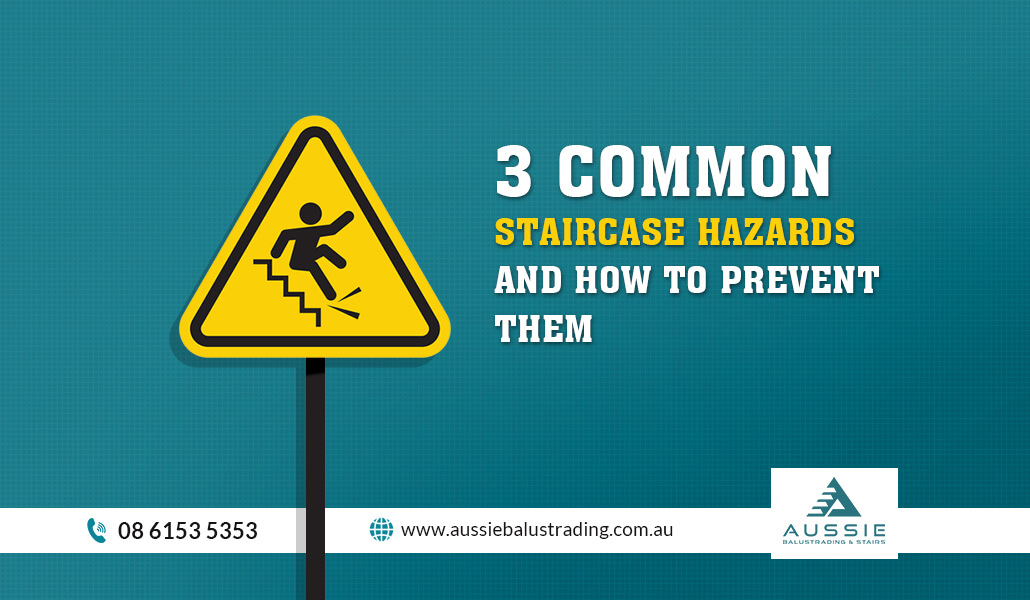The purpose of stairs is to provide people with an easy means of getting from one level to another and are an essential part of any establishment or property with more than one floor. This is why they should be safe and structurally sound.
An astounding amount of people are treated for staircase-related injuries daily, which is why there are plenty of regulations and standards to follow regarding their construction. Design, lighting, visibility and attention all play a part in causing stairway slips, trips, and falls. While there can be no predicting or stopping all of these causes, there are ways to reduce risk and prevent falls from happening.
Below you will find six common staircase hazards responsible for injuries and the ways to prevent them from happening.
Poor Design
According to research, people only pay attention to the first and last three steps of a stairway; therefore, these steps must be designed thoughtfully. The stair riser is the vertical surface of the stair, and the stair tread is the horizontal surface of the stair. Because accidents are more likely to occur going down, the depth of the tread should be wide enough to accommodate the ball of the foot without extending over the tread.
To avoid this, make sure that the tread and riser dimensions are uniform throughout the entire staircase.
There is another aspect to consider in one, two, or three-step stairways commonly found in public buildings like hotels and restaurants. People often suffer “air-step” falls when they fail to notice the presence of these low stairways either falling or tripping over them.
A few ways to address this issue can be by placing a written warning on the leading edge of the stairway or simply creating a visual contrast with the colour yellow—which signals safety. And if at all feasible, consider doing away with the stairs altogether and switching to a ramp instead.
Poor Visibility
People must see where they are going. Poor lighting can hinder them from seeing debris or possible hazards on the stairs before it’s too late.
People that are going down the stairs have a diminished view of the stairs. As they descend, they can only see the floor and the treads. They can’t see the risers preventing them from adequately judging the height of each stair. Dim lighting can be caused by low wattage bulbs or faulty, burnt-out lightbulbs, so it’s best to check the quality of your lighting and see if it needs repairs or replacements.
A good preventative measure is to install floodlight illumination to highlight the stairway and the floor. You can also provide visual contrast on the treads to guide people on their way. If the staircase is located in a low-light area, consider installing step lightings.
Inadequate Stair Rails and Handrails
People can sometimes think of stair rails and handrails interchangeably. While both serve to protect the user, each does so differently. Stair rails prevent people from falling off the edge of the stairs of landings. Handrails provide balance and stability.
If these were missing, damaged, or broken in any way, it could be hazardous for the user. Handrails for stairs should be between 30 to 38 inches starting from the leading edge. For further protection, install a fixed barrier in the space between the handrail and the steps.
A fixed barrier is better; however, if it is for your home, a balustrade could also do the job while also functioning as decoration. If you have children at home, look into child-proof balustrading.
Summary
Falling down the stairs can result in serious injury. While you can’t eliminate the threat of staircase accidents, you can do a lot to prevent them from happening. Better design, attention to detail, and consideration for users will go a long way in keeping people safe. The best way to ensure a safe environment is through consistent maintenance and safety checks.
Aussie Balustrading and Stairs are custom staircase manufacturers providing Australians homes, buildings, and establishments with the safest and best quality staircases. We serve the communities of West Australia and Perth. For more information, contact us today!



